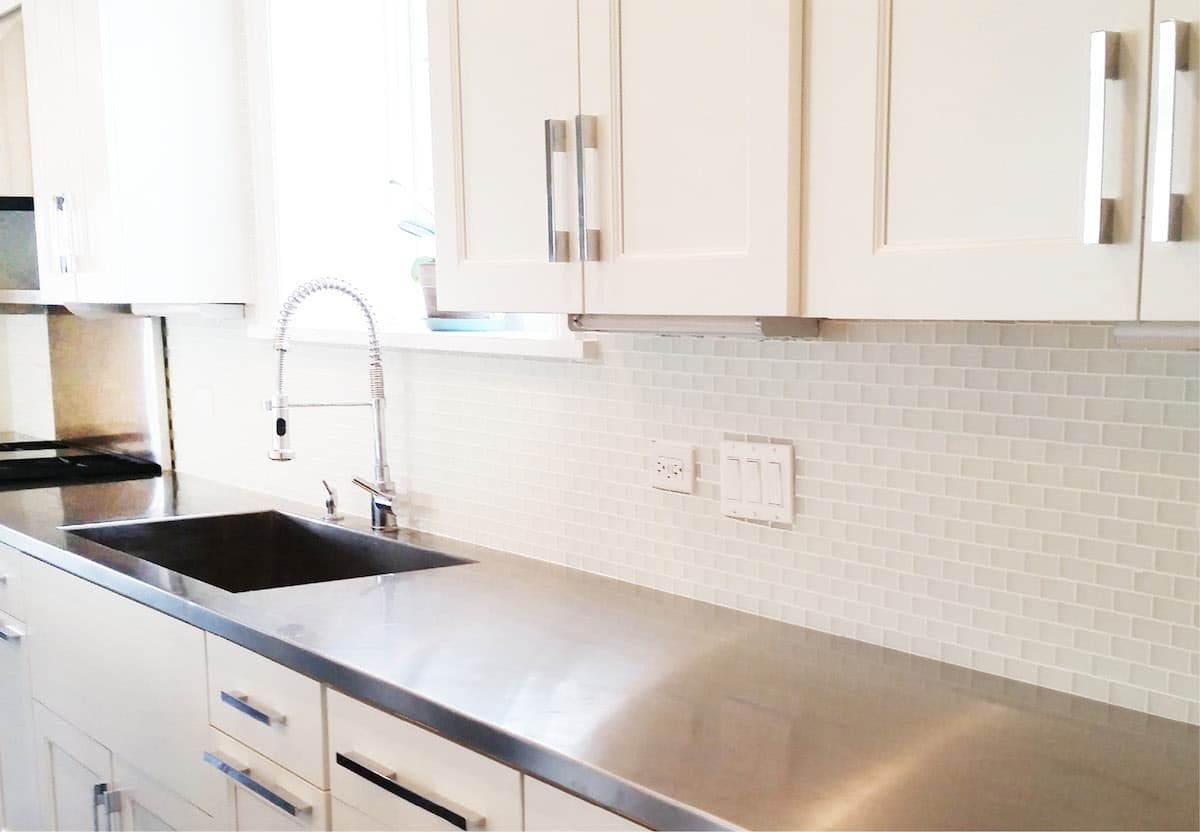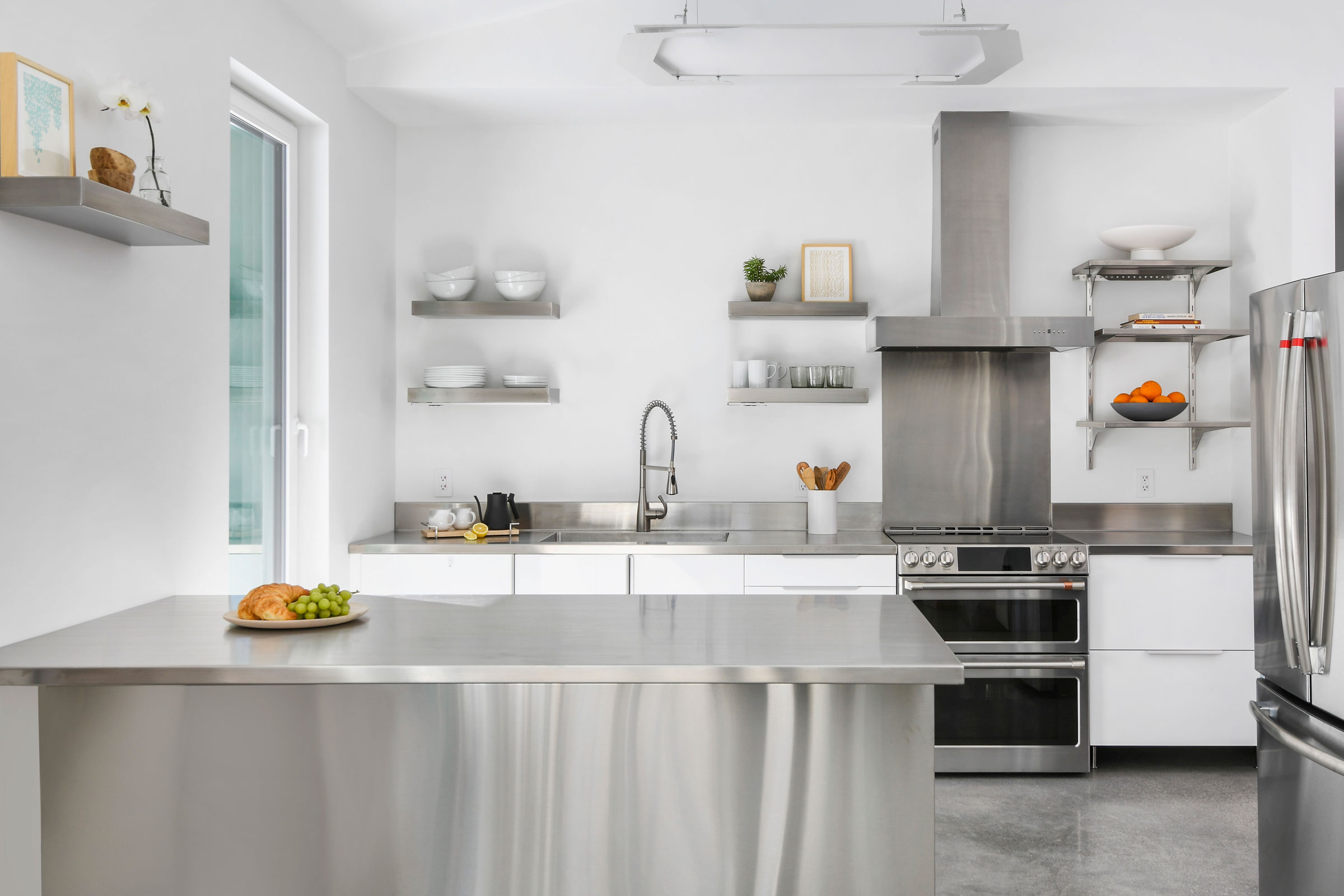Story at a glance:
- Designers hoping for a unique look in kitchens that never goes out of style will find it in metal countertops.
- Durable, hygienic, and easy to clean, metal kitchen countertops are perfect workhorses for busy cooks or bartenders.
- Of all the infinitely recyclable metals used in kitchen countertops, zinc metal possesses the lowest amount of embodied energy.
Plastic laminate, composite stone, and granite have dominated the field of kitchen countertops for decades. But there is an alternative for designers looking for sleek high quality in another material commonly used elsewhere in buildings: metal.
Let’s consider options in metal kitchen countertops with an eye on their sustainability.
Types of Metal Kitchen Countertops
There are three basic metals used to construct kitchen countertops: stainless steel, copper, and zinc.
Stainless Steel
A glistening stainless steel countertop affords a chemically inert durability that only gets better with age. Corrosion resistant, this workspace offers a level of hygiene and practicality that all serious cooks demand. Not only is its smooth surface easy to clean; it doesn’t require extensive maintenance, either.
Naturally durable and built to last, a stainless steel kitchen countertop retains its even, silvery look no matter how many hits and scratches it receives. Although stainless steel resists heat, using trivets for hot pans and pots will protect it for life. Stainless steel worktops are not acid-resistant, so avoid acid-based cleaners. Wipe up minor spills and mishaps with a damp cloth. Treat small scratches with a metal protector, brushing in the direction of the grain.
“It will get some weather marks and it’s not always going to look like it did on day one, but it ages very well.” Bill Lambropoulos, cofounder of Custom Metal Home, tells gb&d in a previous interview.
Designers may also choose a stainless steel kitchen sink that integrates seamlessly with the countertop in one long unit. Backsplashes add a protective sleek border along the wall abutting the countertop.
Copper
A copper metal kitchen countertop or island turns heads when guests enter a room clad in this orange-colored metal. “It’s for people who want someone to come into their kitchen and say, ‘Wow, what’s that?’” Lambropoulos says. “It’s very elegant, and it’s certainly a more expensive material.” Copper’s eye-catching brightness adds an inviting warmth to your kitchen, perfect for family meals and holiday parties.
Compared to stainless steel, copper is a soft metal so extra care is warranted to keep it scratch- and dent-free. This is especially true if you have an adjoining copper sink, where heavy kitchenware could cause dents. Although copper is naturally antibacterial, cutting food directly on it could cause slits to form. A cutting board will avoid this problem.
Unsealed copper countertops oxidize as they age, resulting in a unique, multi-colored patina with red, brown, and green hues. Aged copper adds a rustic feel to a home’s ambiance, and would enhance country or farmhouse décor styles. By contrast, copper countertops sealed with beeswax or a similar substance will maintain their original luster longer when properly cared for.
Spilling acidic food or beverages on copper will cause staining unless cleaned up immediately. Hot pans can cause burn marks. Use of a sink grate and countertop trivets will protect kitchen copper.
Zinc
Like copper, zinc is a reactive soft metal that readily oxidizes. This means its normally gray-green color will become darker blue-gray over time. Zinc may begin to resemble pewter in color. Sealing it with a food-grade wax will slow down oxidation, but not completely stop it.
Speeding up the oxidation is possible with an acid wash. “Some people just love the look of it,” Lambropoulos says. “It’s a very cool, aged metal look, and it’s a bit of a throwback. You see it a lot now in farmhouse style kitchens, with a zinc island and zinc hood against white cabinets.”
Because zinc is so malleable, designers may wish to commission metal workers to add decorative edges and rivets to kitchen countertops or islands, further enhancing zinc’s charm.
Zinc kitchen countertops offer an aged warmth and natural look to any design. Since its patina evolves with time and use, each countertop will be unique. Polished or matte finishes will only contribute to a zinc countertop’s distinctiveness.
As a soft metal, zinc is prone to the same issues as copper metal kitchen countertops. Although you may be tempted to slice food on its antibacterial surface, doing so will damage it, so always use a cutting board. Similarly, hot cookware can warp a zinc countertop. In fact, objects right out of the oven over 300℉ can melt a zinc countertop.
Are Metal Kitchen Countertops Sustainable?

Custom Metal Home’s stainless steel countertops are among their most durable options and long-lasting options. Photo courtesy of Custom Metal Home
Metal kitchen countertops are sustainable in some ways that surpass laminate or composite—including composite stone—countertops. Most notably, metal countertops do not emit VOCs like those from epoxy or comparable resins.
Since all the metals profiled here are infinitely recyclable without loss of structural integrity, purchasing a metal kitchen countertop made exclusively or primarily with recycled metal is preferable. Mining and extraction of metallic ores are incredibly energy-intensive processes, so use of recycled or salvaged kitchen countertops is much more sustainable than purchasing products manufactured from virgin materials.
Which Metal Kitchen Countertop is the Most Sustainable?
Life cycle assessments comparing metals consistently show that zinc has a smaller environmental footprint than several other building materials including copper and stainless steel. Most notably, zinc production has a comparatively lower embodied energy.
Embodied energy includes all of the non-renewable energy used to create a finished product. This includes energy for raw material extraction, transport, manufacturing, assembly, installation, use, and disposal. Zinc requires only one-third the energy of copper or stainless steel. Roughly 95% of the energy content embodied in a zinc product is conserved during recycling. This means that substantially less energy is needed to produce zinc building materials when recycled zinc is used instead of virgin ore.




